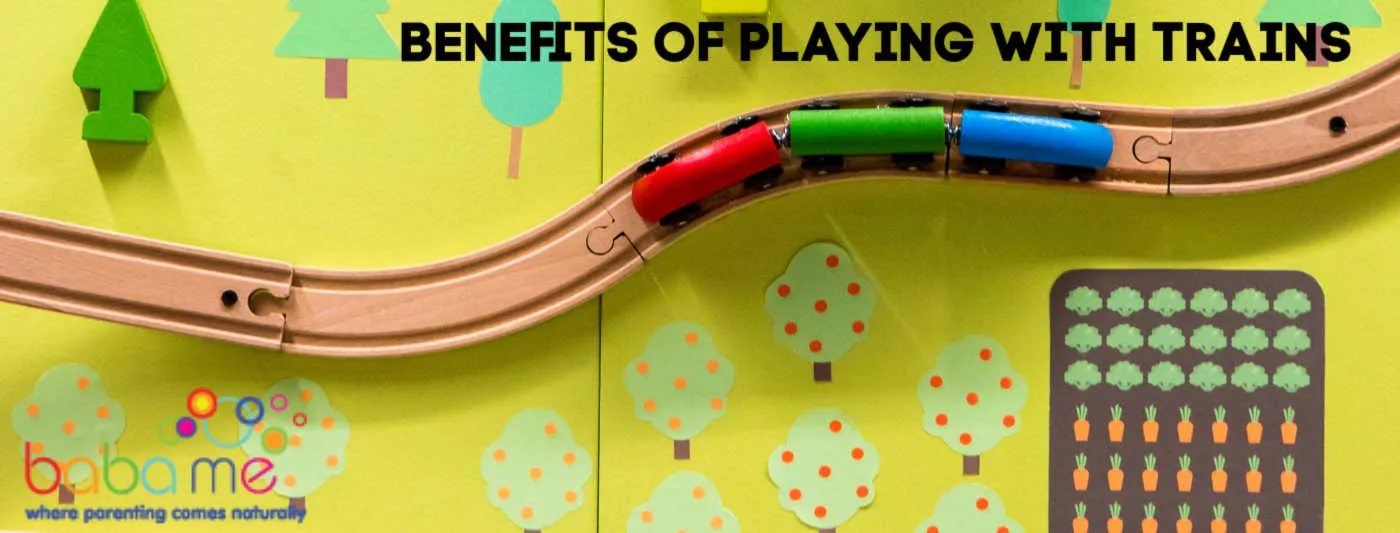Playing with toy trains and train tracks has been a beloved pastime for generations of children and adults.
There’s something enchanting about the sights and sounds of locomotives chugging along their tracks, and the endless possibilities for creativity and imagination that come with building and designing train sets.
But beyond the joy and wonder of train play, there are numerous benefits to be gained from this classic activity. From enhancing cognitive and social skills to fostering creativity and imagination, playing with trains can offer a wealth of developmental opportunities for children and a child’s development.
So, whether you’re a lifelong train enthusiast or just looking for a fun and educational activity for your kids, join us as we explore the many benefits of playing with trains.
Playing with trains is a fun and engaging activity that can offer numerous benefits for children’s development, including enhancing their creativity, imagination, and problem-solving skills.
Train play can also help children develop important social skills such as teamwork, communication, and cooperation, as they work together to design and operate their train sets.
Playing with trains can provide a great opportunity for parents to bond with their children and participate in their play, as well as a chance for children to learn about history, geography, and different types of trains.
Benefits of Playing with Trains
Playing with train sets can be a delightful and educational experience for children. It provides a platform for them to explore, learn, and grow across multiple domains.
| Benefit Category | Description |
|---|---|
| Cognitive Development | – Problem-Solving Skills: Figuring out how to set up tracks or get through obstacles develop problem solving skills. – Spatial Awareness: Understanding how tracks fit together and the spatial relationships between objects. |
| Motor Skills | – Fine Motor Skills: Manipulating small train pieces, connecting tracks, and moving trains along tracks help develop fine motor skills. – Hand-Eye Coordination: Coordinating actions to navigate trains around the tracks improves hand-eye coordination. |
| Language Development | – Vocabulary: Learning new words related to trains, tracks, and actions associated with train play. – Narrative Skills: Creating and narrating stories about the trains’ adventures enhances language and storytelling skills. |
| Social Skills | – Sharing and Cooperation: Playing with trains in a group setting encourages sharing, taking turns, and cooperating with others. – Teamwork: Working together to build complex track layouts fosters teamwork and collaboration. |
| Creativity and Imagination | – Imaginative Play: Creating different scenarios, destinations, and adventures for the trains fosters imaginative play and lets your child develop creativity. – Creative Expression: Designing track layouts and scenes encourages creative expression. |
| Understanding the World | – Real-World Understanding: Understanding basic concepts of transportation, motion, and cause-and-effect through train play. – Engineering Concepts: Exploring simple engineering concepts as they design and build track layouts. |
| Mathematical Thinking | – Basic Counting: Counting trains, tracks, or stations introduces basic math concepts. – Pattern Recognition: Recognizing and creating patterns with tracks or trains. |
| Emotional Development | – Patience and Persistence: Learning patience as they work through challenges and persistence to complete a track layout. – Sense of Accomplishment: Feeling a sense of accomplishment when successfully navigating trains or creating a complex track layout. |
Train play can be a versatile and engaging way to promote learning and development across a range of areas. By providing a supportive and enriched environment, parents and educators can help children maximize the benefits derived from playing with trains.
The many benefits of playing with a train toys go far beyond simply having fun
Children have loved playing with wooden trains for generations. Of course, playing with toys is a great way for children to relax, use their imaginations and blow of steam. But playing is about so much more than just having fun. Play is how children learn.
Putting the pieces of a wooden train track together requires hand-eye coordination and fine motor skills.
But more than that your child needs to plan where each piece will go, they need to avoid furniture, make sure the track is smooth, choose the correct pieces of track so they can incorporate bridges, tunnels and level crossings.
In this way children are not only having fun but they are practising vital skills they will need in later life. They are solving complex problems, they need to employ foresight, patience and trial and error to build the perfect track. And they are learning that there are multiple solutions to the problem they’re trying to solve.
Child’s developmental milestones:
As your child gets old, their train play goes through various child’s developmental stages.
Here’s how train play can align with a child’s developmental milestones:
- Sensorimotor Stage (0-2 years):
- During this stage, infants and toddlers learn through interacting with their environment. Playing with train sets can help them develop motor skills as they grasp, push, and pull the trains along tracks.
- Preoperational Stage (2-7 years):
- Children begin to engage in symbolic play and start to learn how to pretend. Train play can foster imaginative and creative play as they create scenarios, routes, and stories around the train adventures.
- Concrete Operational Stage (7-11 years):
- At this stage, children start to think logically about concrete events. They can plan out train routes, solve problems like how to get the train around obstacles, and understand the cause and effect of their actions.
- Formal Operational Stage (11 years and above):
- Children can think abstractly and hypothetically. They might start to understand more complex systems through train play, like how real-world transportation systems work, and can plan out more complex train routes.
Throughout these stages, train play can also encourage social development as children play together, learning to share, communicate, and collaborate. It also fosters patience, attention to detail, and a love for learning and exploration.
Key benefits of playing with train sets
Here are just a few reasons why you might want to invest in a train set for your child.
- Fine motor skills. Developing good fine motor skills at a young age is hugely beneficial for development as these are the skills you need for writing, drawing, tying your shoelaces and using a knife and fork. Putting the track together, pulling the trains around and operating bridges and turntables is all great for fine motor skills and you can add extra elements such as people, buildings and animals to increase the use of fine motor skills.
- Problem solving. Children learn to build a track through trial and error, figuring out how to make a circular track that trains can continuously go round. This ability to see A and relate it to B is a lifelong skill but one that needs to be learned and practised none the less.
- Vocabulary and communication skills. Playing with trains can be really beneficial to your child’s vocabulary and communication skills. Not only does pretend play enhance vocabulary through the description and storytelling. But children also learn valuable sequencing skills as they play.
- Learning about concepts. There are plenty of concepts your children can learn as they are playing with trains. You can talk about the past, future and present. Learn about over and under, through or around, left and right and counting.
- Creativity and imagination. The beauty of a train set is that children can set it up in a different way every time they play. Train sets are also perfect for imaginative storytelling and can be combined with lots of other toys for hours of small world play.
- Gross motor skills. It might not be the skill you first think of when train sets come to mind but children also have to gain spatial awareness and learn about how much space they themselves take up in order to play successfully without breaking the track. There’s also a lot of crouching, crawling, lying on the floor and stepping over things involved in a good game of trains.
Enhancing Cognitive Development
Playing with trains can enhance cognitive development by improving problem-solving skills, developing logical thinking, and enhancing memory skills.
- Improving problem-solving skills: Playing with trains requires children to think critically and solve problems, such as how to construct tracks and overcome obstacles. Children who play with trains learn how to approach problems logically and think creatively to find solutions.
- Developing logical thinking: Train play involves arranging tracks and cars in a logical order, helping children develop their logical thinking skills. Children who play with trains learn how to organize information and create sequences of events, which can translate into improved problem-solving abilities in other areas.
- Enhancing memory skills: Children who play with trains are encouraged to remember the layout of the tracks and the order of the cars, improving their memory skills. They must recall specific details in order to successfully operate their train sets.
Improving Hand-Eye Coordination
Playing with trains requires children to manipulate objects and coordinate their movements, which can improve their hand-eye coordination.
- Placing tracks and cars: Children who play with trains must place tracks and cars in specific locations, which requires hand-eye coordination and fine motor skills.
- Operating trains: Children must also operate trains at different speeds and directions, which requires coordination between their hands and eyes.
- Using accessories: Train play often involves using accessories such as switches and crossings, which require hand-eye coordination and spatial awareness.
Fostering Creativity and Imagination
Playing with trains allows children to create their own worlds and scenarios, encouraging creative thinking and storytelling.
- Designing layouts: Children who play with trains can design their own layouts, using their imaginations to create unique environments for their train sets. They can use different types of tracks, accessories, and buildings to create a one-of-a-kind setting.
- Creating stories and scenarios: Children who play with trains can also create stories and scenarios for their trains, such as a rescue mission or a journey to a far-off land. This encourages creative thinking and storytelling, as they imagine new and exciting adventures for their trains.
Developing Social Skills
Playing with trains can help children develop social skills by encouraging cooperative play and communication with others, including sharing, taking turns, and working together towards a common goal.
- Encouraging cooperative play: Playing with trains often involves teamwork, as children work together to build tracks and operate trains. This type of cooperative play can help children develop important social skills such as sharing, taking turns, and working together towards a common goal.
- Promoting communication skills: Children who play with trains are also encouraged to communicate with one another to discuss ideas, make decisions, and solve problems. This type of communication can help children develop important social skills such as expressing their thoughts and ideas, listening to others, and working collaboratively.
Improving Spatial Awareness
Playing with trains can improve spatial awareness by requiring children to plan and construct layouts, and navigate the trains through twists, turns, and tunnels.
- Planning and constructing layouts: Children who play with trains must visualize and plan in three dimensions, which can help improve their spatial awareness skills. They must also construct tracks and arrange cars to fit within a specific space, requiring spatial reasoning and problem-solving abilities.
- Navigating trains: Children must navigate trains through twists, turns, and tunnels, which requires spatial awareness and hand-eye coordination.
Providing Educational Opportunities
Playing with trains can provide educational opportunities by teaching children about different types of trains, how they operate, and the history behind them, as well as learning about geography by creating layouts that represent different regions.
- Learning about trains: Children who play with trains can learn about the different types of trains, how they operate, and the history behind them. This can foster an interest in trains and
- lead to further exploration of trains and their place in history and society.
- Learning geography: Children can also learn about geography by creating layouts that represent different regions, such as a mountainous area or a cityscape. This can help them understand the layout and geography of different regions, as well as the types of transportation used in those areas.
- Exploring STEM concepts: Playing with trains can also introduce children to STEM concepts, such as physics and engineering. They can experiment with different track layouts and accessories to see how they affect the speed and direction of the trains, and learn about the science behind how trains operate.
Best Starter Train Set

BRIO World Classic Railway Set
Endless Imaginative Play with the BRIO World Classic Railway Set
Discover endless imaginative play with the BRIO World Classic Railway Set. Made with high-quality, sustainable materials, this durable train set is perfect for your little engineer. Expandable and customizable, the Classic Railway Set provides hours of fun and creative exploration for kids of all ages. Buy now and start building your own custom railway today!
- Encourages imaginative play and creativity: The endless possibilities for track layouts and custom designs encourages children to use their imagination and creativity to build their own unique railway.
- Enhances fine motor skills and hand-eye coordination: As children manipulate the train cars and tracks to create their own designs, they develop fine motor skills and hand-eye coordination.
- Provides hours of fun and entertainment: The BRIO World Classic Railway Set is a great way to keep children entertained for hours on end, providing endless opportunities for imaginative play and exploration.
- High-quality, durable construction for long-lasting use: Made from high-quality, sustainably sourced wood, the BRIO World Classic Railway Set is built to withstand the wear and tear of everyday play, ensuring that it will provide years of fun and enjoyment for children.
FAQs on Benefits of Playing with Trains
At what age can children start playing with trains?
Children can start playing with trains as young as two or three years old, with age-appropriate sets available for different age ranges.
What types of train sets are available?
There are many types of train sets available, ranging from simple wooden sets for young children to more advanced electric sets for older kids and adults.
Can playing with trains help with autism spectrum disorder?
Yes, playing with trains can be a beneficial activity for children with autism spectrum disorder, as it can help improve social skills, communication, and imaginative play.




